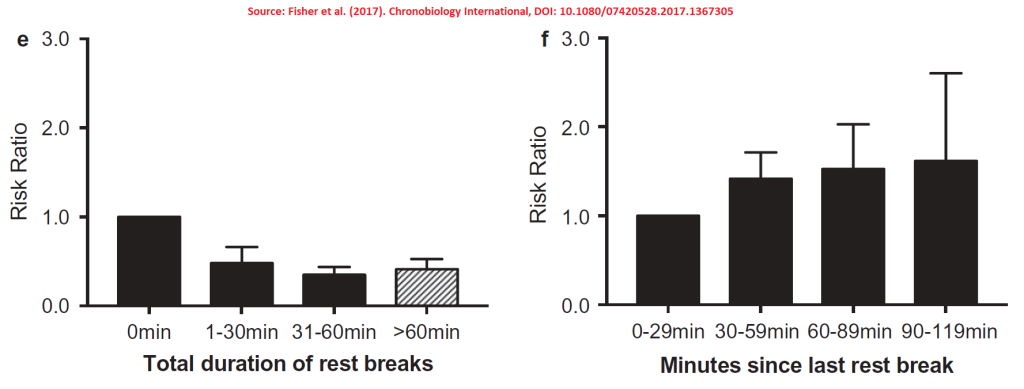Are the terrors really in the night or are they rather in your biology or your workplace?
This study explored the links between the risk of occupational injuries and work scheduling arrangements, such as long working hours, shift work and rest breaks- drawing on 29 high-quality studies.
The data are presented as risk ratios relative to a “standard” shift. Say the risk of an injury over the course of a 9 to 5, Mon to Fri shift is presented as 1, and the risk of changing to an afternoon shift is now 1.5, then that group is 1.5 times the risk to experience an accident (50% higher than day shift). A change from a RR of 1 to 2 means 2 times the risk of an injury (a doubling of injury risk). Values lower than 1 indicate a lesser chance of injury.
Key findings included:
• Injury risk increased by 36% on night shifts compared to morning shifts.
• Injury risk on afternoon/evening shifts increased by 12% relative to morning, but this wasn’t statistically significant.
• Number of hours on duty significantly increased injury risk > 9th hour exponentially and “almost tripled it after the 12th hour at work resulting in a 34% increase for shifts longer than 12 hours” (p12).
• For number of consecutive shifts, RR wasn’t significantly elevated for consecutive morning shifts but injury risk was elevated by the 4th consecutive night shift (36% increase).
• Rest breaks—both frequency & duration—were protective of injuries, but more pronounced with frequency such that injury risk increased with every additional half hour spent working relative to the first 30 min of work (but it’s said there was a paucity of data here, so caution is needed).



In answering the opening question – we can say that:
a) while the terrors are frequently encountered in the night, with reliable increases of injury risk during night shift relative to morning/day shifts (among other relationships),
b) and the underlying causal mechanisms are a biological need for sleep and circadian influences among other neurobehavioural and physiological factors (to paraphrase Drew Dawson and Kirsty McCulloch “fatigue: it’s about sleep, stupid”)
c) it’s largely organisational factors and design which release those “terrors” into the workplace.
That is, while fatigue most definitely *is* about sleep and physiology, it’s organisation’s that largely create the hazardous intersections with human neurobehavioural performance and workplace conditions (even accounting for the dual-responsibility of fatigue between workers and companies).
So…I guess, your boss isn’t a monster but holds the key to the cage?
a. Study link: http://dx.doi.org/10.1080/07420528.2017.1367305
b. Link to the original LinkedIn article: https://www.linkedin.com/pulse/updating-risk-index-systematic-review-meta-analysis-work-hutchinson
c. Link to the repost: https://www.linkedin.com/posts/benhutchinson2_are-the-terrors-really-in-the-night-or-are-activity-6950941363584540672-uw5F?utm_source=linkedin_share&utm_medium=member_desktop_web
One thought on “Terrors in the night or terrors at your workplace? Sleep, shiftwork schedules and accidents/injuries”